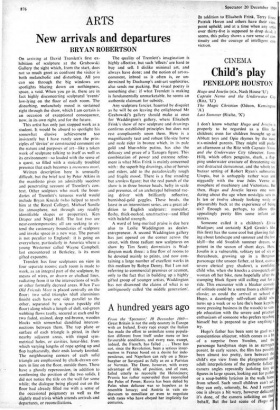ARTS New arrivals and departures
BRYAN ROBERTSON
On arriving at David Tremlett's first ex- hibition of sculpture at the Grabowski Gallery the sight which, from the start, does not so much greet as confront the visitor is both melancholic and disturbing. All you can see through the big windows are spotlights blazing down on nothingness, space, a void. When you go in, there are in fact highly disconcerting sculptural 'events' low-lying on the floor of each room. The disturbing, melancholy mood is sustained right through the show, which I am certain is an occasion of exceptional consequence, now, in its own right, and for the future.
This artist has only just stopped work as a student. It would be absurd to spotlight his somewhat elusive achievement too insistently but I have rarely seen the prin- ciples of 'device' or constructed comment on the nature and purposes of art—like a token work of sculpture talking to itself as well as its environment—so loaded with the sense of a quest, so filled with a stoically troubled presence that each becomes a memento mori.
Written description here is unusually difficult, but the brief text by Peter Atkins in the manifesto gives an admirably succinct and penetrating account of Tremlett's con- text. Other sculptors who mark the boun- daries of Tremlett's tenuous world would include Bryan Kneale (who helped to teach him at the Royal College), Michael Sandie (in atmosphere, not through any readily identifiable shapes or properties), Ken Draper and Nigel Hall. The last two are near-contemporaries; all are seeking to ex- tend the customary boundaries of sculpture and invoke space in a new way. The pursuit is not peculiar to England : it is going on everywhere, particularly in America where a young Westerner called Wayne Campbell, last encountered at Berkeley, is its most gifted expondbt.
Tremlett has four sculptures on view in four separate rooms; each room is made to work, as an integral part of the sculpture, by means of wires, or drawn or chalked lines, radiating from it to the intersections of walls or other formally decreed areas. When Two Old Friends Meet is placed centrally on the floor: two solid triangles (dull aluminium finish) each have one side parallel to the other, separated by a space (speckly old floor) along which a length of dull, sad-green webbing flows tautly, secured at each end by two faded, stained, deep red-brown, wooden blocks with somewhat dandified intercon- nections between them. The top plane or surface of each triangle is pitted, in their nearby adjacent areas, with ringed sym- metrical holes, or cavities, lunar-like, from which varying lengths of rope spring up and flop haphazardly, their ends loosely knotted. The neighbouring corners of each solid triangle are emphasised by chalk-drawn cor- ners in line on the floor, outside them. These have a ghostly repercussion, in addition to confirming the position of the two solids. I did not notice the title on the wall for some while; the dialogue being played out on the floor had already filled me with a sense of the occasional poignancy as well as the slightly mad trivia which attends arrivals and departures, or reconciliations. The quality of Tremlett's imagination is highly affective, but such 'effects' are hard to buy and sell. I dislike minimal art, and always have done; and the notion of art-as- comment, inbred as it often is, or un- dermined by Duchamp's anti-art sophistries, also sends me packing. But visual poetry is something else: if what Tremlett is making is fundamentally unmarketable. he seems an authentic claimant for subsidy.
Any sculpture fancier, haunted by disquiet as he will be on leaving the enlightened Mr Grabowski's gallery should make at once for Waddington's gallery, where Elisabeth Frink's show of new sculpture and drawings confirms established principles but does not rest complacently upon them. Here is a magnificently taut and robust life-size horse and male rider in bronze which, in its pale gold and blue-white patina, has also the delicacy and grace of a Tanagra figure. This combination of power and extreme refine- ment is what Miss Frink is mainly concerned with : the superb big drawings, also of horses and riders, add to the paradoxically tough and fragile mood. There is a fine standing but armless figure; but the real punch of the show is in three bronze heads, hefty in scale and presence, of an archetypal helmeted rac- ing driver with brilliantly reflective, burnished-gold goggles. These heads, the latest in an intermittent series, are a great ad- dition to English sculpture: muscular, fleshy, thick-necked, unattractive—and filled with baleful strength.
A word of long-merited praise is due here also to Leslie Waddington as dealer- entrepreneur. A second Waddington gallery has just opened on the corner across the street, with three radiant new sculptures on show by Tim Scott; downstairs is Wad- dington mark three: a fine flow of rooms to be devoted mainly to prints, and now con- taining a large number of excellent works in this medium by Robyn Denny. But I am not referring to commercial premises or acumen, only to the fact that in building up a highly gifted group of younger artists, Waddington has not disowned the claims of what is so ambiguously called 'the middle generation'. In addition to Elisabeth Frinlc, Terry Frost, Patrick Heron and others have their view. point upheld; and at a time when any artist over thirty-five is supposed to drop dead, it seems, this policy shows a rare sense of con- tinuity and the courage of intelligent con- viction.


































 Previous page
Previous page